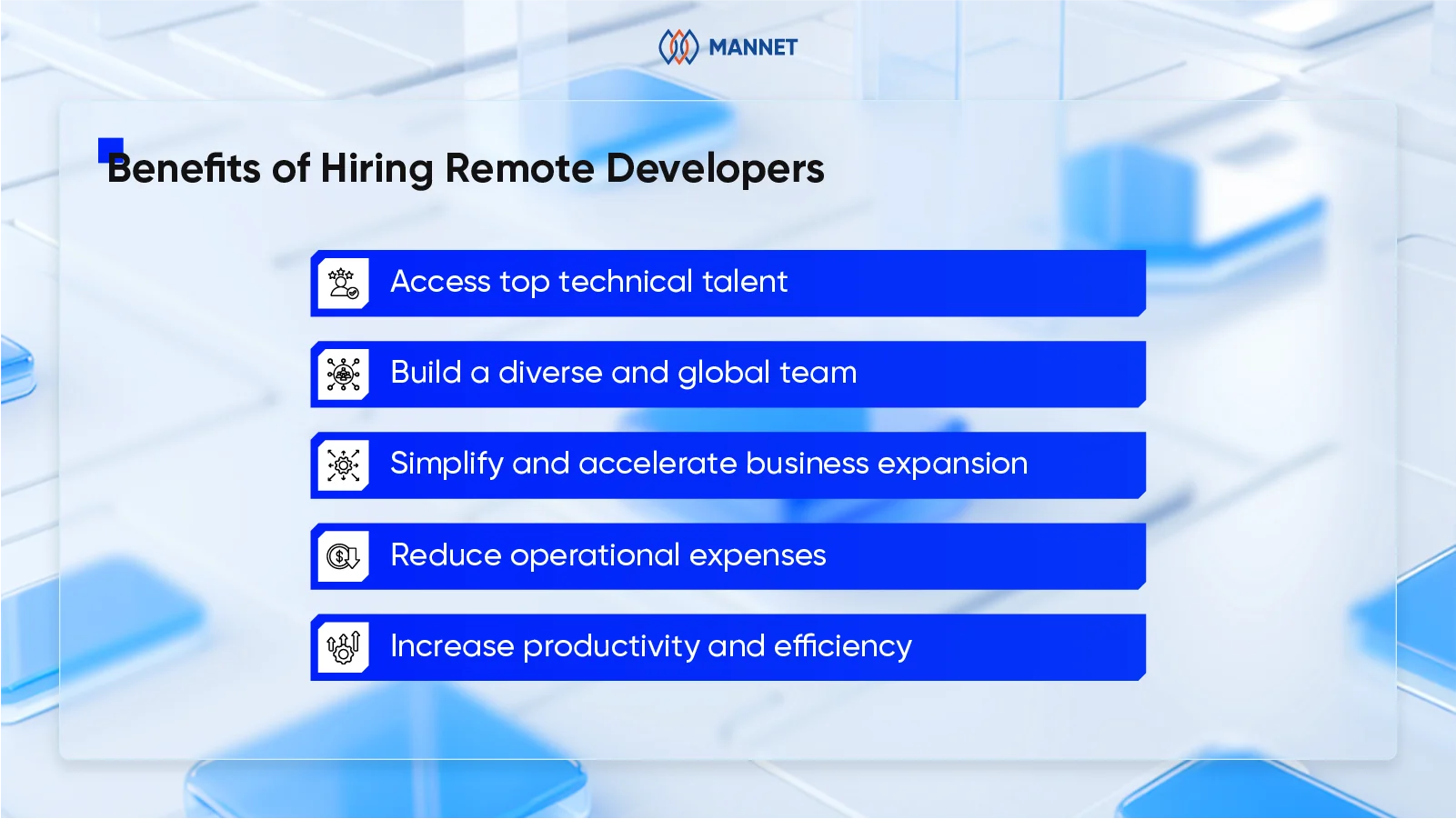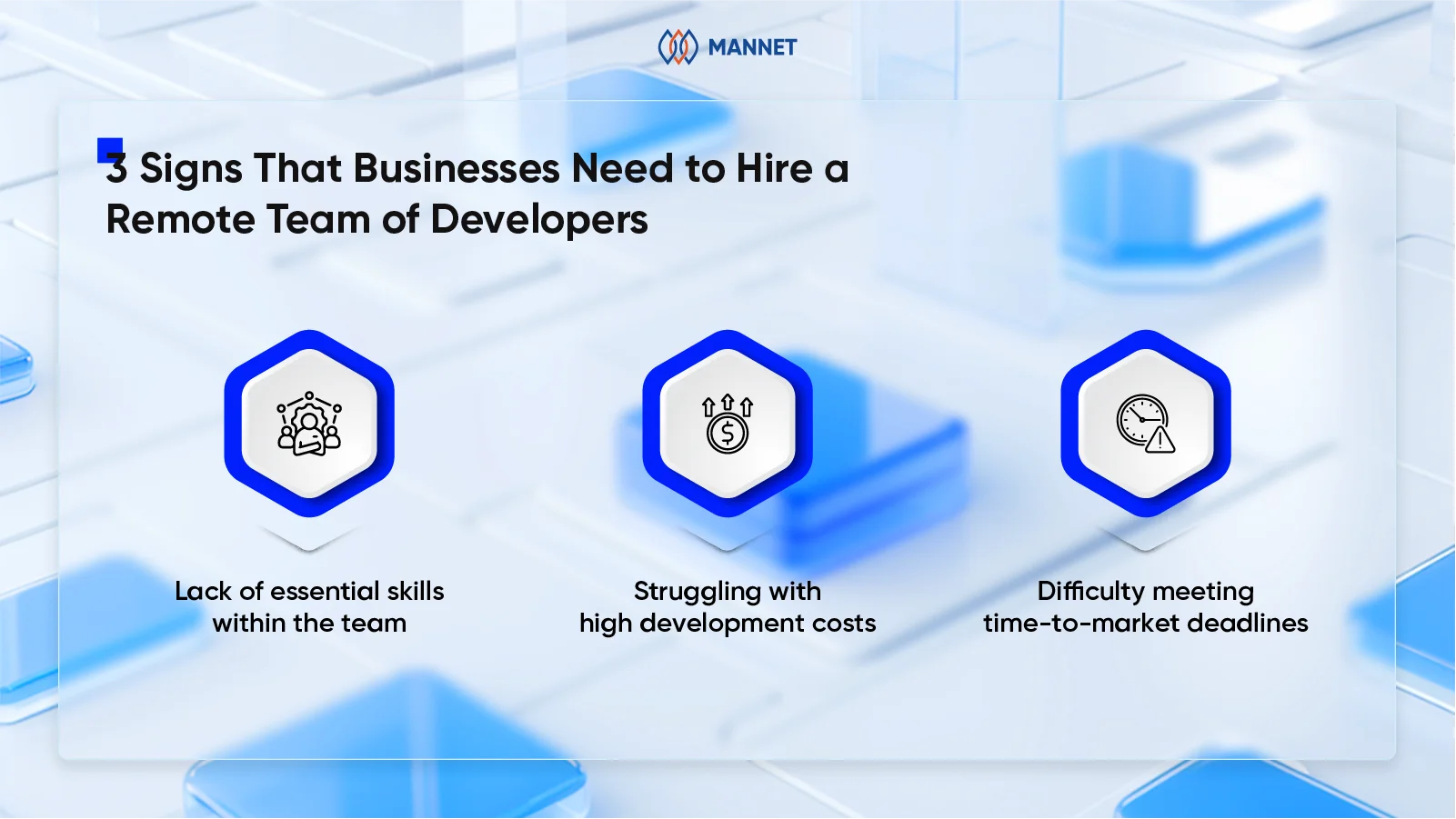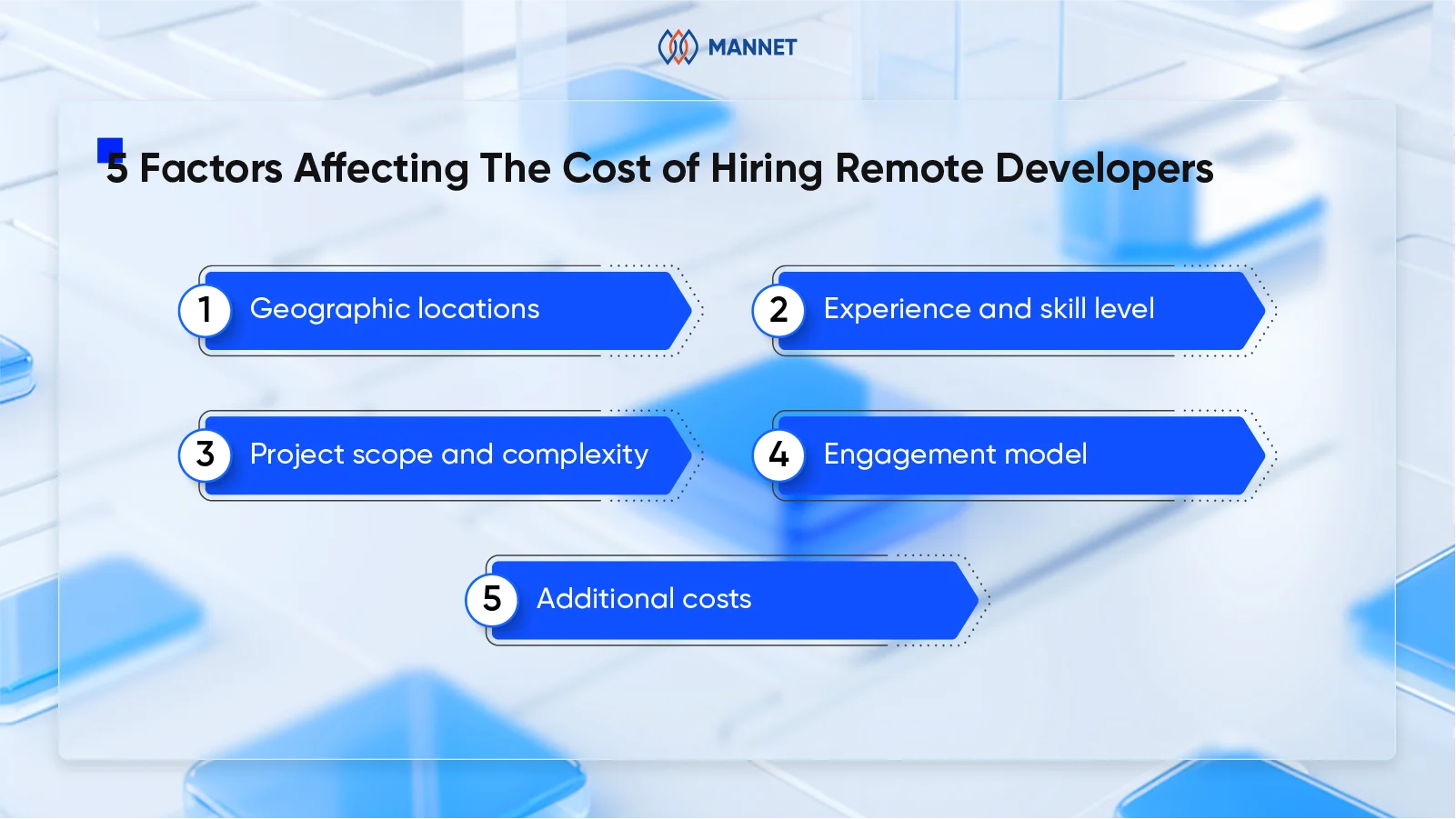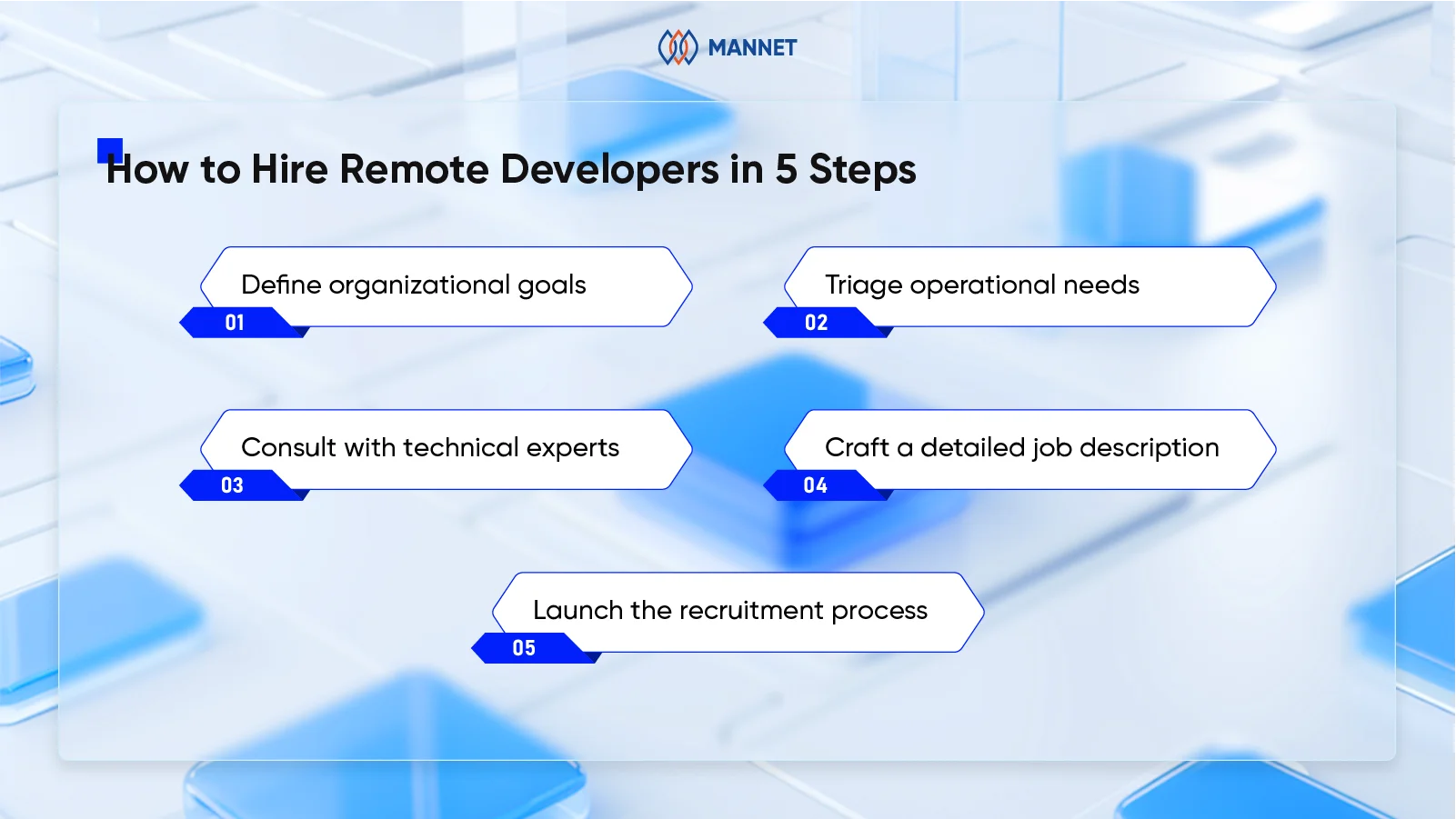The share of employees working remotely worldwide has grown significantly in recent years, jumping from 20% in 2020 to 28% in 2023. In particular, the technology industry leads the way, with 67% of tech employees reporting that they work primarily remotely (Statista, 2023).
As the demand for remote developers continues to rise, understanding how to hire remote developers has become essential for businesses looking to scale their technical teams. The ability to tap into a global talent pool not only increases the chances of finding the right expertise but also offers significant cost advantages.
This guide will walk businesses through the key steps and considerations involved in hiring remote developers. By the end of this guide, organizations will have a clear, actionable plan for navigating the complexities of remote recruitment and a step-by-step approach to successfully building a high-performing remote development team.
Now, let’s get started!
Why Should Businesses Hire Remote Developers?
Hiring remote developers offers businesses access to a wider talent pool, greater flexibility, and cost savings. Here are some key benefits that make remote hiring an attractive option for scaling teams and driving innovation.

Why businesses should hire remote developers?
Access top technical talent
The most compelling reason to hire remote developers is access to a vastly expanded talent pool. When geographic constraints are removed, companies can recruit specialized developers with niche skills that might be scarce or unavailable locally. This global approach to talent acquisition enables organizations to find perfect-fit candidates with specific technology expertise, rather than settling for the best available option within commuting distance.
Build a diverse and global team
Remote hiring naturally facilitates greater diversity in technical teams. By recruiting developers from different countries and cultural backgrounds, companies gain fresh perspectives that can drive innovation. Research consistently shows that diverse teams produce more creative solutions and better business outcomes.
Additionally, a globally distributed development team can provide round-the-clock productivity when strategically positioned across time zones.
Simplify and accelerate business expansion
When businesses expand into new markets, having remote developers already familiar with those regions provides a significant advantage. Remote teams can help navigate local technical requirements, compliance issues, and cultural nuances that might otherwise slow market entry. This distributed presence enables faster scaling without the overhead of establishing physical offices in each location.
Reduce operational expenses
Hiring remote developers can lead to significant cost savings. Companies can save on expenses such as office rent, utilities, hardware, and additional benefits typically associated with in-house teams. Employers can save on average around $11,000 annually for each employee who works remotely two or three days a week, according to a 2021 study by research firm Global Workplace Analytics.
Increase productivity and efficiency
Remote developers frequently demonstrate higher productivity levels than their office-bound counterparts. Without daily commutes and with greater schedule flexibility, remote team members often report higher job satisfaction and better work-life balance, which translates to improved performance and retention.
A study by Stanford University found that companies that adopted remote work policies experienced a productivity increase of up to 13%. Modern collaboration tools and well-structured remote work policies ensure seamless teamwork despite physical distance.

Productivity increases when adopting remote work
Signs That Businesses Need to Hire a Remote Team of Developers
For businesses struggling with specific challenges, hiring a remote team of developers may be the solution. Below are some common signs that it’s time to look for remote developers:

Signs to hire remote developers
Lack of essential skills within the team
A clear indicator that organizations should consider hiring remote developers is when technical skill gaps create bottlenecks in development cycles. When existing teams lack expertise in emerging technologies like artificial intelligence, blockchain, or specialized framework experience, bringing in remote specialists can immediately address these deficiencies without extensive training programs or project delays.
Struggling with high development costs
When development expenses consistently exceed budgets or industry benchmarks, remote hiring offers a viable solution. Companies facing prohibitive costs in tech hubs like Silicon Valley, London, or Tokyo can access equally qualified talent in regions with lower cost structures, effectively balancing quality and affordability without compromising on technical excellence.
Difficulty meeting time-to-market deadlines
Missed deadlines and extended development cycles often signal the need for additional expertise or capacity. Remote developers can be onboarded more quickly than local hires in competitive markets, allowing companies to accelerate project timelines. Furthermore, distributed teams working across time zones can implement follow-the-sun development approaches, dramatically reducing time-to-market for critical products.
How Much Does It Cost to Hire the Best Remote Software Developers?
The cost to hire top-tier remote software developers varies significantly but generally ranges from $30 to $100+ per hour for freelancers and $50,000 to over $150,000 annually for full-time positions.

Cost to hire remote developers
However, calculating the investment needed to hire a remote team of developers can be challenging. The cost typically depends on various factors, including those below. Here’s a more detailed breakdown:
Key factors affecting the cost of hiring remote developers

Factors affecting the cost of hiring remote developers
Geographic locations
Different regions around the world offer varying levels of talent, but prices can differ drastically due to disparities in local economies, living costs, and demand for skilled professionals.
For example, developers in the United States or Western Europe typically command higher rates, reflecting the higher cost of living in these regions and the strong demand for top-tier talent. In contrast, developers from Asia, Eastern Europe, and Latin America often offer more affordable rates without compromising on skill. Many companies choose to hire developers from these regions to optimize their budget while still accessing highly qualified talent.
Experience and skill level
Generally, the more experienced a developer is, the higher their hourly rate will be. Junior developers typically cost 30-50% less than their senior counterparts. However, developers with advanced expertise in high-demand areas such as machine learning, data science, or cloud architecture tend to command premium rates.
While hiring less experienced developers can offer cost savings, it’s essential to balance these savings with the efficiency and quality that more seasoned developers bring. Experienced developers can tackle complex issues more effectively and deliver faster results, which can ultimately reduce costs in the long term.
Project scope and complexity
The complexity of a project is directly proportional to the development cost. Simple projects, such as a basic website or mobile app, require fewer resources and expertise, making them more affordable. However, complex projects such as custom software development, enterprise-level applications, or solutions involving advanced technologies like blockchain or AI demand more time, effort, and specialized knowledge, driving up the overall cost.
When evaluating the cost, organizations should consider not only the development time required but also the long-term maintenance and scalability needs of their project. More intricate projects require careful planning and a higher level of expertise, which will reflect in the cost.
Engagement model
There are different approaches to hiring developers, each with its own advantages and cost implications:
- Direct hiring: Directly hiring remote developers gives enterprises more control over the hiring process, but it often comes with recruitment fees and long-term employment expenses (such as salaries, benefits, and taxes).
- Freelance platforms: Hiring through freelance platforms like Upwork or Toptal offers flexibility and access to a broad range of talent, but freelancers tend to charge higher hourly rates due to their project-based nature.
- Outsourcing companies: Partnering with specialized outsourcing companies provides a middle ground. These companies handle recruitment, project management, and administrative tasks while ensuring quality control. Although outsourcing tends to be more structured, it eliminates the direct recruitment and employment burdens associated with hiring individually.
Additional costs
Beyond the developer’s hourly rate, it’s essential to factor in additional costs that may arise during the hiring process. These can include recruitment fees when hiring through an agency or platform, as well as the cost of software licenses and tools required for collaboration and version control. Businesses may also need to consider the cost of project management software, communication tools, and data security measures to protect sensitive information.
Moreover, there might be onboarding and training costs associated with integrating remote developers into the existing team. While remote work offers great flexibility, it also requires investing in the right infrastructure to ensure smooth collaboration and project delivery.
How to Hire Remote Developers?
Hiring remote developers can be a fantastic way to access top talent, cut costs, and scale businesses quickly. But to make it work, every company needs a clear process. In this part, let’s explore a simple, actionable guide to help businesses hire the right remote developers for the team.

How to hire remote developers
Step 1. Define organizational goals
The first step in the hiring process is to define organizational goals. Understanding the purpose behind integrating remote developers is crucial. Is the aim to accelerate product development, expand an existing team, or address a specific skill gap? Clarifying these goals will guide decisions regarding the type of developers needed and the appropriate channels to source them.
For example, if the goal is rapid product development, businesses might prioritize developers who are experienced in agile methodologies and continuous integration. On the other hand, if the primary concern is cost optimization, companies may want to target developers in regions with a good balance of quality and affordable rates.
Step 2. Triage operational needs
The next step is to conduct a thorough assessment of the company’s operational needs. This means reviewing current technical capabilities and understanding the specific gaps that need to be filled.
Let’s take these key factors into account:
- Technical stack: Identify the technologies needed (e.g., Python, JavaScript, AWS) and verify that developers are skilled in those areas.
- Project complexity: Evaluate if the project is straightforward (e.g., a website or app) or more complex (e.g., custom software or AI), as this will determine the level of expertise required.
- Team integration: Assess the level of collaboration needed between the remote developer and the in-house team, determining if the developer should work independently or closely with others.
- Security and compliance: For regulated industries (e.g., healthcare, finance), check that the developer has experience with relevant security standards and compliance regulations.
Step 3. Consult with technical experts
To find the right remote developer, it’s critical to collaborate with internal technical experts like the CTO or technical leads, who can pinpoint the exact skills and experience required for the role. These professionals play a pivotal role in defining the technical needs of the project and identifying potential challenges that may arise in a remote working environment.
If the internal team lacks the capacity or expertise to support the hiring process, consider leveraging IT recruitment services providers. These partners can offer access to a broader talent pool and provide guidance on market trends and available talent.
IT headhunting firms like ManNet specialize in connecting businesses with pre-vetted developers, saving time while ensuring candidates meet the technical and cultural needs. This approach helps avoid common challenges, such as miscommunication and mismatched skill sets.
Step 4. Craft a detailed job description
Beyond listing required programming languages and frameworks, articulate how remote developers will collaborate with existing teams, expected communication practices, and performance metrics.
To create effective job descriptions for remote developers, companies should consider incorporating the following elements into their checklist:

Job descriptions for remote developers
- Technical requirements: Be specific about the programming languages, frameworks, and tools the developer should be familiar with.
- Remote work expectations: Clarify the working hours, time zone flexibility, and the communication tools used (Slack, Zoom, etc.).
- Collaboration style: Explain how the developer will work with other team members, whether they will work independently or integrate closely with the internal team.
- Project management tools: Specify any project management software used, like Jira or Trello.
- Remote-specific requirements: Mention any home office setup requirements or preferred internet speed for efficient remote work.
Step 5. Launch the recruitment process
After crafting a detailed job description and identifying the specific skills needed, it’s time to launch the recruitment process. Organizations can start with those recruitment channels:
- Remote-specific job platforms like We Work Remotely, Remote OK, and Stack Overflow Jobs
- Developer communities such as GitHub, GitLab, and specialized Slack groups
- Referral programs incentivize existing team members to recommend qualified candidates
If the company has already partnered with an IT HR outsourcing service, it can bypass much of the manual recruitment process.
Outsourcing firms handle the time-consuming aspects of recruitment, such as sourcing candidates, conducting initial screenings, and ensuring technical expertise, so organizations can focus on evaluating the candidates who match the needs of the companies. They also offer flexibility in terms of engagement models, whether businesses are looking for freelancers, contractors, or full-time remote employees.
Moreover, if the internal hiring team of the business lacks the expertise or bandwidth to evaluate specific technical skills, outsourcing partners can offer additional guidance on what to look for and help manage the hiring process from start to finish.
FAQs About Hiring Remote Developers
- What are the main benefits of hiring remote developers?
Hiring remote developers allows companies to tap into top talent from around the world, build diverse teams, and expand more quickly. It also helps reduce costs and boosts overall productivity by offering flexibility and access to highly skilled professionals.
- What are the best platforms to find and hire remote software developers?
Effective sources for remote developer talent include:
- Specialized remote job boards (We Work Remotely, Remote OK, Stack Overflow Jobs)
- Developer communities (GitHub, GitLab, specialized Slack groups)
- Remote work platforms (Toptal, Arc, Turing)
- Developer-focused social networks (LinkedIn with targeted search parameters)
- Technical outsourcing partners with established talent networks
- Referral programs incentivizing existing team members
A multi-channel recruitment strategy typically yields the best results, allowing companies to compare candidates from different sources.
- How do businesses manage remote developers across different time zones?
Businesses handle remote developers in different time zones by using tools like Slack, Zoom, and Trello for seamless communication and project management. They set overlapping working hours for key collaboration moments and rely on asynchronous communication for tasks that don’t need instant feedback. By setting clear expectations and holding regular check-ins, businesses ensure everything runs smoothly and stays on track.
A Summary of Hiring Remote Developers
In summary, remote developers offer businesses the flexibility to scale project teams rapidly and efficiently. However, it’s important for businesses to thoughtfully consider all the factors involved before deciding to hire remote talent.
At ManNet, we make it easier for companies to build their dream remote development teams. Our platform matches businesses with pre-vetted developers who are not only experts in their fields but are also time-zone aligned and equipped with the soft skills needed.
When you choose to work with ManNet, you will receive huge tech support, as we got many years of IT recruitment and IT staff augmentation experience. We take the guesswork out of recruitment so you can focus on growing your business.
Let’s connect today and start building your remote team!



